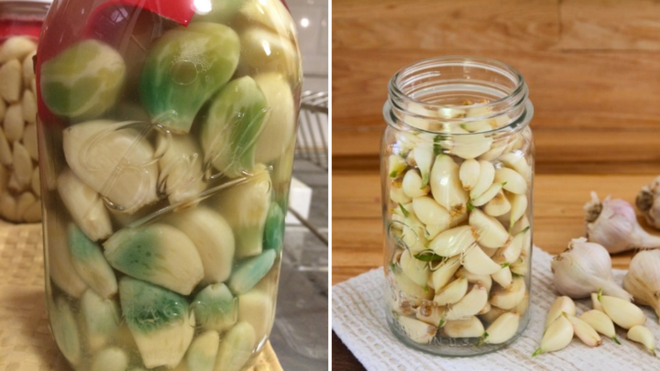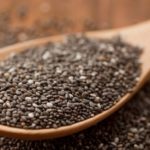Pickled garlic in vinegar is a popular condiment in many dishes such as rice vermicelli and cellophane noodles, or used in dipping sauces. It stimulates the taste buds, balances flavors, and offers various health benefits. However, the phenomenon of pickled garlic turning green has raised concerns among many people. Is the jar of garlic spoiled and unsafe to consume?
Why Does Pickled Garlic Turn Green?
It is quite common for pickled garlic to turn green, and this can be frustrating as the final product doesn’t look perfect. This phenomenon is related to the acidity of the vinegar. When it comes into contact with garlic, vinegar reacts with amino acids present in the garlic, forming pyrroles.
These pyrroles combine to form polypyrroles, resulting in a color change: four pyrroles combined produce a green color, while three pyrroles combined turn the jar of pickled garlic blue.
Therefore, it is normal for pickled garlic to turn green or blue, and it is still safe to consume as the color change does not affect the flavor of the garlic. This color change usually occurs with young garlic or when the pickling solution is not at the correct concentration. You don’t need to worry about the blue or green garlic; it is still edible, so don’t throw it away and create waste.

It is normal for pickled garlic to turn green or blue. (Image: Pinterest)
Health Benefits of Pickled Garlic
Garlic, in general, is considered a potent remedy for various health issues. Both fresh and pickled garlic have been proven to provide significant benefits, such as improving high blood pressure and encouraging wound healing. The health benefits of pickled garlic include:
Boosting the immune system: Pickled garlic contains antioxidants and antibacterial compounds, which strengthen the immune system and reduce the risk of infections.
Aiding digestion: Pickled garlic helps balance gut bacteria, supports the digestion process, and alleviates indigestion, bloating, and nausea.
Fighting bacteria and viruses: Garlic inhibits the growth of disease-causing bacteria and viruses in the body.
Supporting the circulatory system: Pickled garlic improves blood circulation, reduces the risk of blood clots, and enhances cardiovascular health.
Lowering cholesterol levels: Garlic decreases bad cholesterol (LDL) and increases good cholesterol (HDL) levels, thus maintaining cardiovascular health.
How to Make Pickled Garlic
To make delicious pickled garlic that doesn’t turn green, choose older garlic bulbs with dry and wrinkle-free outer skins. Before pickling, thoroughly peel the garlic cloves. To make the peeling process faster and avoid tears, soak the garlic in water for 20 minutes and then peel.
Gather the ingredients for pickled garlic:
– Vietnamese garlic
– Eating vinegar
– Seasoning powder
– Sugar
– Green and red rice paddy chilies
Rinse the chilies, let them air dry, and remove the stems. Peel and slice the garlic lengthwise, then soak them in a bowl of vinegar. Cover the bowl with plastic wrap and refrigerate for an hour. After that, take them out and transfer them to another bowl. Mix the garlic with the prepared sugar and seasoning powder for about 15 minutes to allow the flavors to absorb.
For the pickling jar, choose a clean porcelain jar that is completely dry. Alternately layer the chilies and garlic until the jar is full, then pour in enough vinegar to submerge the garlic. Tightly close the jar and store it in a cool, dry place for two days before transferring it to the refrigerator for long-term storage. Note: Use clean chopsticks or spoons that have not been used for anything else to take out the garlic.
Exploring the Benefits of Chia Seeds on Good Health: What You Need to Know
Did you know that chia seeds come from the same family as herbs that are used in spices such as mint and basil? These seeds are a popular health food due to their unique health benefits. Read on to find out how these seeds can be used and why they're so beneficial!





































